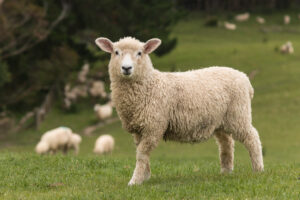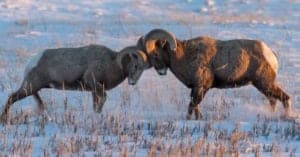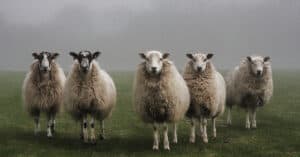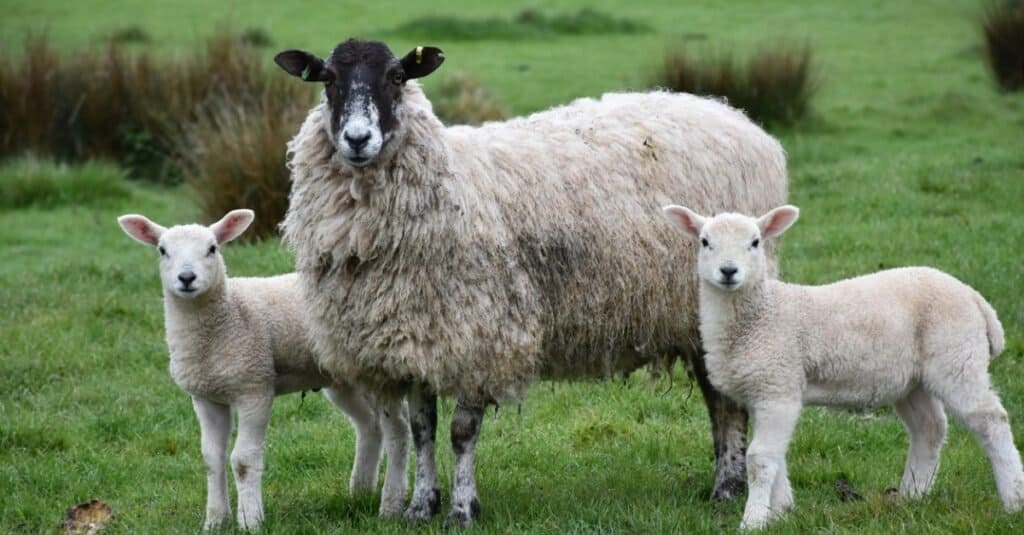
Two lambs stand on either side of this full-grown sheep.
©iStock.com/DejaVu Designs
Do you sometimes look at lambs and sheep and wonder ‘Are lamb and sheep the same’? There’s a good reason lambs and sheep look similar. A lamb is a baby sheep. A female sheep is known as an ewe, and a male sheep is known as a ram. Their offspring are called lambs.
Sheep (Ovis aries) were among the first and most successful domesticated animals in the world. They have been part of human society for thousands of years. We still depend on sheep and lambs for many things, including wool, meat, and milk.
There are millions of domesticated sheep and lambs in the world, and there are also many wild sheep species. Examples of wild sheep include the Rocky Mountain bighorn, the stone sheep and the chamois, and the ibex. Popular domesticated breeds include merino, Suffolk, and cheviot sheep.
Comparing Lamb vs Sheep
| Lamb | Sheep | |
|---|---|---|
| Size | 5 to 12 pounds | 150 to 300 pounds |
| Coat | Soft and fluffy | Shaggy |
| Horns | None | Large and curly |
| Diet | Ewe milk | Grasses and legumes |
| Sociability | With its mother and siblings | Alone or in a flock |
The 5 Key Differences Between Sheep and Lambs Explained
Are lamb and sheep the same? Lambs and sheep share many similar features, which isn’t surprising since they are the same animal at different ages. All the same, they have more than one major difference.
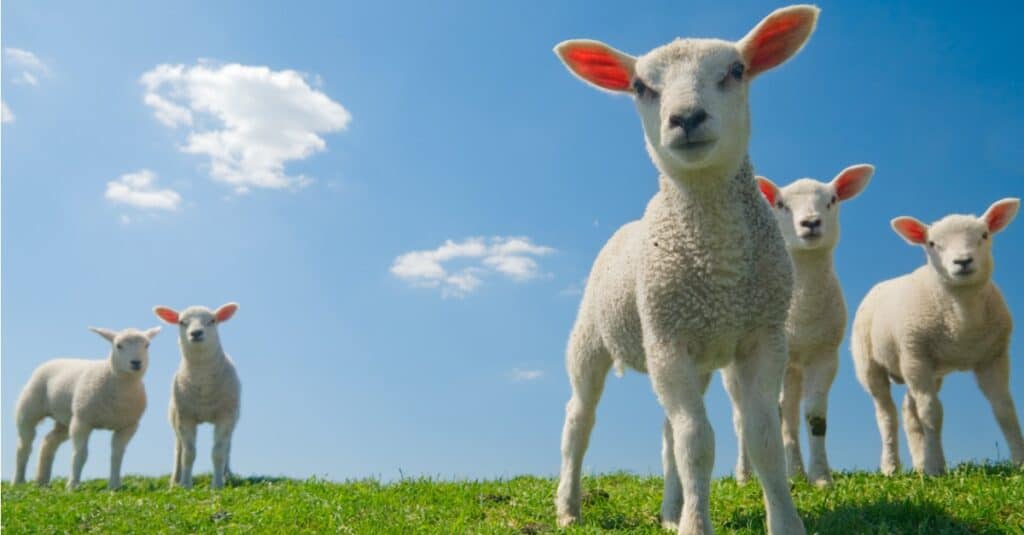
Lambs are much smaller and fluffier before they grow into sheep.
©iStock.com/Enjoylife2
1. Lamb vs Sheep: Size
Lambs are noticeably smaller than adult sheep. A newborn lamb might weigh from 5 to 10 pounds at birth. Fully-grown sheep are much larger, and wild sheep are usually even larger.
The largest sheep species is the argali (Ovis ammon), a wild sheep native to Mongolia. It can stand 4 feet tall and weigh from 200 to more than 700 pounds. Hunting and deforestation have made the argali endangered.
2. Lamb vs Sheep: Coat
Although both lambs and sheep produce wool, there is a difference in their coats. Lamb’s wool is softer and more delicate than sheep’s wool.
For this reason, lambswool yarn is quite popular for sweaters and blankets. A lamb’s first shearing will occur near 6 months of age. Since a lamb’s wool is finer and softer at this life stage, it makes an even cozier blanket when compared to traditional, adult wool.
3. Lamb vs Sheep: Horns
Most lambs don’t have horns. Male lambs might have tiny bumps that resemble horns, but they are nowhere near as big as a ram’s horns.
4. Lamb vs Sheep: Diet
A lamb drinks ewe milk during its first few weeks of life. After that, it eats the normal sheep’s diet of grasses, flowers, and legumes.
5. Lamb vs Sheep: Sociability
Baby lambs usually hang out with their mother and siblings. After they become yearlings, they live in the pasture close to their family members. Domestic sheep are social. Wild sheep are more solitary and spend their time roaming the mountainside alone.
Sheep Lifespan
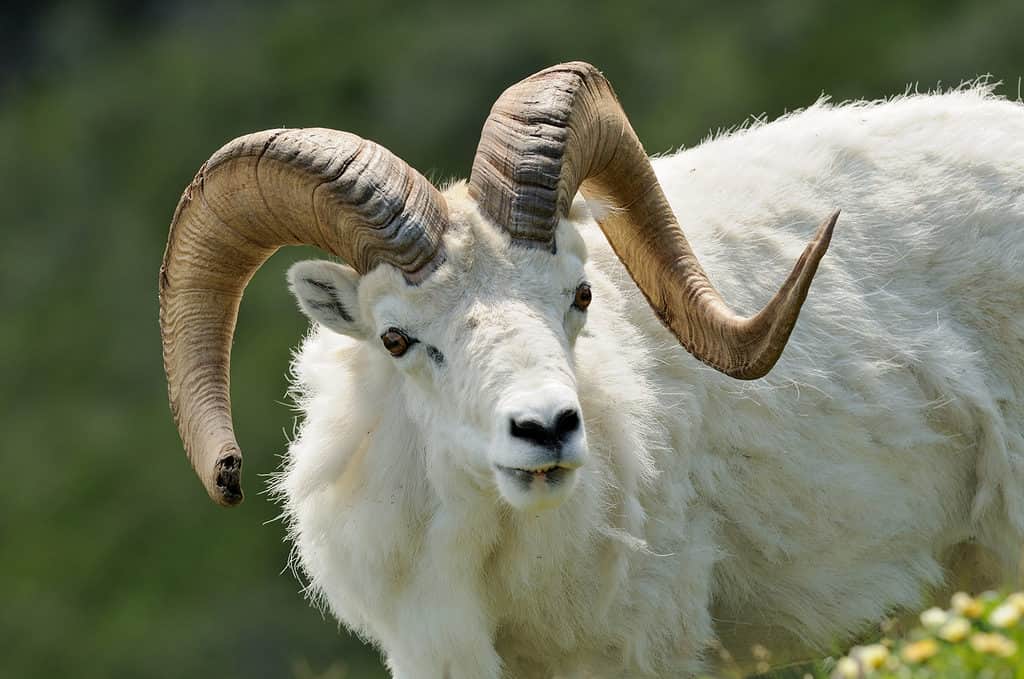
Male sheep often boast impressive curly horns that grow mostly during the 2nd and 3rd years of life but continue growing throughout their lives.
©iStock.com/mlharing
In general, sheep can be expected to live about 10 to 12 years in captivity. The most notable exception and oldest sheep to ever live was a Welsh ewe by the name of Methuselina who lived to be almost 26 years old. Lambs are considered to be full-grown sheep at about 1 year old, or after they have given birth to their first lambs of their own.
Other Differently Named Baby Animals
Now that we have answered the question ‘Are lamb and sheep the same?’ Many other species of baby animals are usually not termed baby followed by whatever animal it is; there is usually a different term used. As lamb is to sheep, these other baby animals are:
- Puppy (dog)
- Joey (kangaroo)
- Calf (cow, hippo, buffalo, etc.)
- Pup (seal, shark, hamster, etc.)
- Cub (bear, cheetah, hyena, raccoon, etc.)
- Hatchlings (reptiles, emus, squids)
- Fledgling (birds)
Summary: Lambs vs Sheep
| Lambs | Sheep |
|---|---|
| 5-10 lbs | 200-700 lbs |
| Soft, delicate wool | Thick, sturdy wool |
| Male lambs lack horns | Male sheep have horns |
| Lambs drink milk | Sheep eat grass, flowers, legumes |
| Lambs associate with their mother & siblings | Domesticated: social Wild: solitary |
Are Goat and Sheep the Same?

Whether in young form, a baby sheep is called a lamb and a baby goat is called a kid, or in the adult form, sheep and goat, these two animals are completely different species. Although they are closely related, as they both belong to the family Bovidae, sheep (Ovis arise) is in the genus Ovis while the goat Capra hircus) comes from the genus Capra.
Both species have different characteristics in which you can tell them apart. The first is their coat texture. Sheep have a very thick wool coat while goats generally have fine white hair covering their bodies. Second is their horns – goat horns come in a variety of shapes from straight and curved to corkscrew. A sheep will have two types, depending on the sex. Ewes will have a fairly short, backward curving horn and rams will have horns that spiral in a loop.
The photo featured at the top of this post is ©
FAQs (Frequently Asked Questions)
Is a Lamb a Baby Sheep?
Yes, a lamb is a baby sheep.
Why Do We Eat Lamb but Not Sheep?
We eat sheep, but you may not be familiar with sheep dishes since few people refer to it as “sheep meat.” If you have ever eaten mutton or hogget, you have eaten an adult sheep. Mutton is flavorful meat that’s popular in Asia and the U.K.
Are Sheep and Lambs Related?
A lamb is a sheep that is a year old or younger. When it’s between one and two years old, it’s known as a yearling. After that, it’s an adult sheep. An adult female is a ewe, and an adult male is a ram or buck. A castrated male sheep is called a wether.
Is a Lamb a Goat or a Sheep?
A lamb is a sheep. Goats are similar to sheep, but they’re a distinct species. A baby goat is known as a kid.
Thank you for reading! Have some feedback for us? Contact the AZ Animals editorial team.



